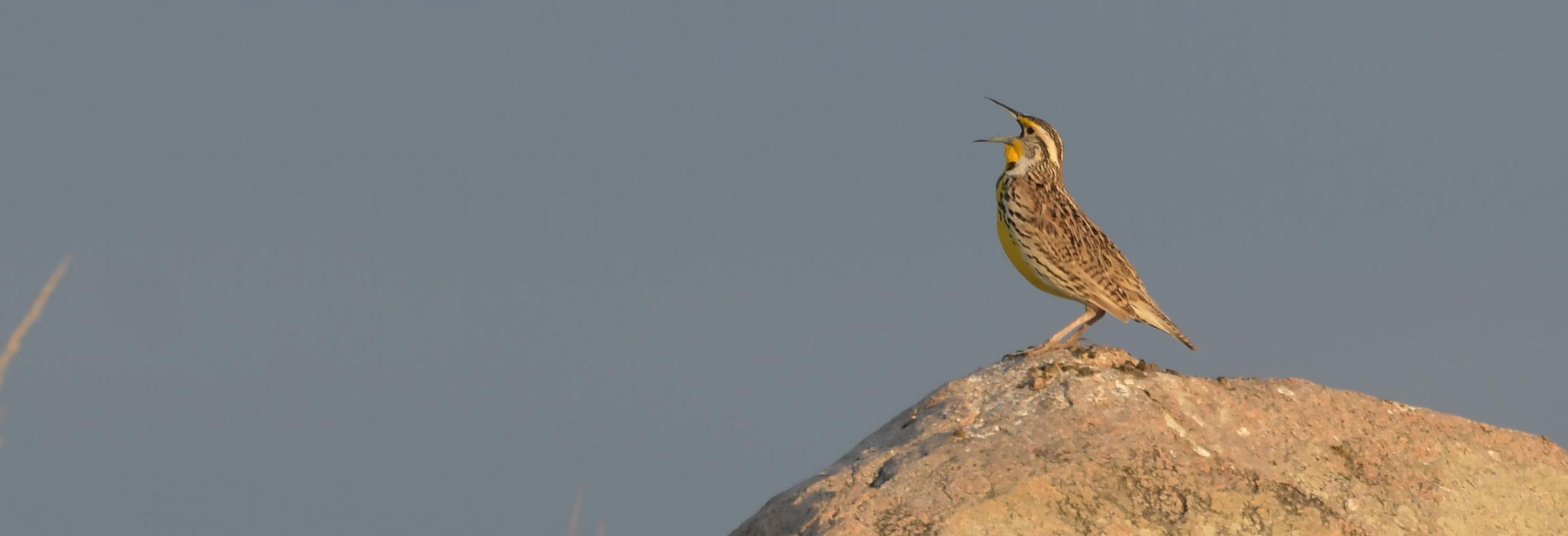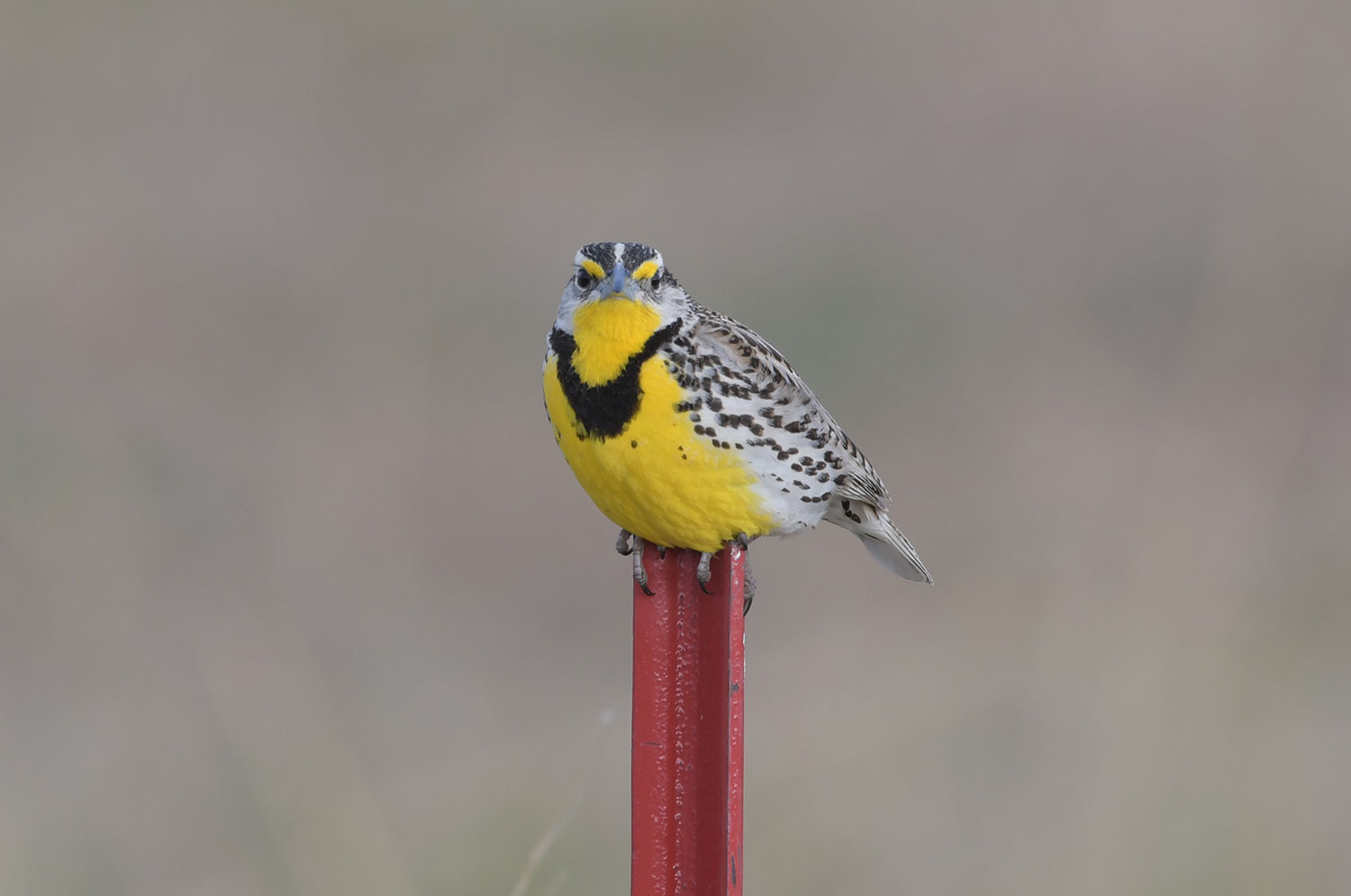
Powerful Prairie Melody Fading
How much do you know about the Western meadowlark? When you were in elementary school, you learned it’s the state bird of North Dakota. You also know it’s one of our earliest migrants, appearing on fenceposts and roadsides in mid-March, about the same time snow geese fill the skies and pasque flowers are ready to burst. You know the meadowlark’s unmistakable song, a sweet and powerful melody that never gets tiresome. Just thinking about the song makes it start playing in your head, right?
Now, let’s see how much you really know about meadowlarks with this short quiz.
1. The Western meadowlark is a member of which bird family?
- New World sparrows (Passerellidae). Birds include American tree sparrow, song sparrow and spotted towhee.
- Thrushes (Turdidae). Birds include Eastern bluebird, Swainson’s thrush and American robin.
- New World blackbirds (Icteridae). Birds include yellow-headed blackbird, Baltimore oriole and common grackle.
- Larks (Alaudidae). Just one other bird in this family, the horned lark.
Not a Lark
While it’s tempting to put the meadowlark in the same category as other delightful songbirds, or the lark family, which by its name makes sense, the answer is actually (C), the blackbird family.
Now, that doesn’t mean the meadowlark is a blackbird. Birds are organized by families, which are a taxonomic classification where members of a family are more closely related to each other than to members of another family.
The Western meadowlark is more closely related to a yellow-headed blackbird, both morphologically and genetically, than it is to a horned lark. Most members of the Icteridae family share these common features: medium-long and sharply pointed bills; long, pointed wings; plumages are predominantly either black or brown, with some having patches of red, yellow, orange; and songs composed of clear, liquid notes.
From that description, it’s clear meadowlarks, orioles and even the blackbirds, have a lot in common.
2. True or False. A male meadowlark will have two mates at one time.
Two Times the Work
True. Some males may have one mate, but many others will have two or even three mates at the same time. Males are the first to arrive on the breeding grounds in North Dakota, around mid-March, having left the warm wintering grounds in the southern Plains states and northern Mexico.
3. True or False. Theodore Roosevelt described the meadowlark as “the prince of them all, the Missouri skylark” but admitted they were “very good eating.”
Not for Consumption
False. When you read the June 2020 issue of North Dakota OUTDOORS, you learned the Sprague’s pipit is the bird Roosevelt referred to as the “prince of them all.” If you’ve read “Hunting Trips of a Ranchman,” then you know the long-billed curlew is the bird Roosevelt described as “very good eating.” Recognize when Roosevelt harvested a curlew, there were no protections on the birds. So please do not attempt eating a curlew today.
4. The Western Meadowlark was formally described by:
- Merriwether Lewis
- John James Audubon
- George Bird Grinnell
- Theodore Roosevelt
Look Alike, Sound Different
John James Audubon. In spring 1843, Audubon journeyed from St. Louis, up the Missouri River to the confluence of the Missouri and Yellowstone rivers, in what is now North Dakota. He was on a quest to collect and describe the “Quadrupeds of North America.” His journal, and his companions, noted seeing many ‘Meadow-larks’ whose songs and single notes were quite different from the meadowlarks of the Eastern states.
The first specimens were collected on May 24, 1843, in what is now South Dakota, and were difficult to distinguish visually from the Eastern meadowlark (Sturnella magna). However, Audubon and his companions determined this abundant bird on all the prairies be considered a separate species, the Western meadowlark.
Audubon gave it the scientific name Sturnella neglecta (the Latin word for neglected or ignored), since it had been vastly overlooked by earlier settlers, even Lewis and Clark, who had presumed it was the same species as its eastern counterpart.
There are few reports of Eastern meadowlarks being observed in North Dakota. However, most people would not know if they saw one, because they are nearly identical in outward appearance to our Western meadowlarks. The surefire difference is in their song, with the Eastern’s being flutelike, but plainer, and rather unremarkable when compared to a Western meadowlark. The ranges of the two species overlap in parts of the central United States, but both being very territorial, they do not share the same space. Therefore, hybridization is very rare.
5. Fill in the blank. The last time you saw or heard a meadowlark was____________________.
Fading, but not Gone
So, when and where was the last time you saw or heard a Western meadowlark? If you live in an area of the state where there are still a good number of cattle ranches, meadowlarks might be a common sight and sound in your daily life. For others who live in a large city or in places where few cattle producers remain, it has likely been awhile since you were in the company of a meadowlark?
Sadly, North Dakota’s state bird is declining at a rate of about 1.3% annually. Is it just a coincidence the meadowlark is declining at roughly the same rate as the number of cattle operations in the United States, about 1% per year? The reduction in grass reconstruction programs, like CRP, also equates to fewer meadowlarks. Bottom line: without working ranches keeping pastures and rangeland green side up, there will be far fewer meadowlarks in our state.
If you haven’t seen a meadowlark in quite some time, now is the time to change that. Take a drive in the country and where there are grasslands and pastures, look for meadowlarks on fenceposts. You may hear them before you see them, even with the windows up. View them safely from the side of the road, don’t enter private land without permission. But if you do cross paths with the landowner or rancher, remember to thank them for the meadowlarks.


